1. Charalampopoulos D, McLoughlin A, Elks CE, Ong KK. Age at menarche and risks of all-cause and cardiovascular death: a systematic review and meta-analysis. Am J Epidemiol. 2014; 180(1):29–40. PMID:
24920784.

2. Karapanou O, Papadimitriou A. Determinants of menarche. Reprod Biol Endocrinol. 2010; 8(1):115. PMID:
20920296.

3. Tanner JM. Trend towards earlier menarche in London, Olso, Copenhagen, the Netherlands and Hungary. Nature. 1973; 243(5402):95–96. PMID:
4706636.
4. Sørensen K, Mouritsen A, Aksglaede L, Hagen CP, Mogensen SS, Juul A. Recent secular trends in pubertal timing: implications for evaluation and diagnosis of precocious puberty. Horm Res Paediatr. 2012; 77(3):137–145. PMID:
22508036.

5. Herman-Giddens ME, Slora EJ, Wasserman RC, Bourdony CJ, Bhapkar MV, Koch GG, et al. Secondary sexual characteristics and menses in young girls seen in office practice: a study from the Pediatric Research in Office Settings network. Pediatrics. 1997; 99(4):505–512. PMID:
9093289.

6. Cabrera SM, Bright GM, Frane JW, Blethen SL, Lee PA. Age of thelarche and menarche in contemporary US females: a cross-sectional analysis. J Pediatr Endocrinol Metab. 2014; 27(1-2):47–51. PMID:
23959659.

7. Ahn JH, Lim SW, Song BS, Seo J, Lee JA, Kim DH, et al. Age at menarche in the Korean female: secular trends and relationship to adulthood body mass index. Ann Pediatr Endocrinol Metab. 2013; 18(2):60–64. PMID:
24904853.

8. Cho GJ, Park HT, Shin JH, Hur JY, Kim YT, Kim SH, et al. Age at menarche in a Korean population: secular trends and influencing factors. Eur J Pediatr. 2010; 169(1):89–94. PMID:
19504269.

9. Lee MH, Kim SH, Oh M, Lee KW, Park MJ. Age at menarche in Korean adolescents: trends and influencing factors. Reprod Health. 2016; 13(1):121. PMID:
27662834.

10. Kim SH, Huh K, Won S, Lee KW, Park MJ. A significant increase in the incidence of central precocious puberty among Korean girls from 2004 to 2010. PLoS One. 2015; 10(11):e0141844. PMID:
26539988.

11. Kim JH, Yun S, Hwang SS, Shim JO, Chae HW, Lee YJ, et al. The 2017 Korean National Growth Charts for children and adolescents: development, improvement, and prospects. Korean J Pediatr. 2018; 61(5):135–149. PMID:
29853938.

12. Okasha M, McCarron P, McEwen J, Smith GD. Age at menarche: secular trends and association with adult anthropometric measures. Ann Hum Biol. 2001; 28(1):68–78. PMID:
11201332.
13. Chumlea WC, Schubert CM, Roche AF, Kulin HE, Lee PA, Himes JH, et al. Age at menarche and racial comparisons in US girls. Pediatrics. 2003; 111(1):110–113. PMID:
12509562.

14. Hwang JY, Shin C, Frongillo EA, Shin KR, Jo I. Secular trend in age at menarche for South Korean women born between 1920 and 1986: the Ansan Study. Ann Hum Biol. 2003; 30(4):434–442. PMID:
12881142.

15. Christensen KY, Maisonet M, Rubin C, Holmes A, Flanders WD, Heron J, et al. Progression through puberty in girls enrolled in a contemporary British cohort. J Adolesc Health. 2010; 47(3):282–289. PMID:
20708568.

16. Papadimitriou A, Fytanidis G, Douros K, Bakoula C, Nicolaidou P, Fretzayas A. Age at menarche in contemporary Greek girls: evidence for levelling-off of the secular trend. Acta Paediatr. 2008; 97(6):812–815. PMID:
18460111.

17. Rigon F, Bianchin L, Bernasconi S, Bona G, Bozzola M, Buzi F, et al. Update on age at menarche in Italy: toward the leveling off of the secular trend. J Adolesc Health. 2010; 46(3):238–244. PMID:
20159500.

18. Roelants M, Hauspie R, Hoppenbrouwers K. References for growth and pubertal development from birth to 21 years in Flanders, Belgium. Ann Hum Biol. 2009; 36(6):680–694. PMID:
19919503.

19. Aksglaede L, Sørensen K, Petersen JH, Skakkebaek NE, Juul A. Recent decline in age at breast development: the Copenhagen Puberty Study. Pediatrics. 2009; 123(5):e932–e939. PMID:
19403485.

20. Talma H, Schönbeck Y, van Dommelen P, Bakker B, van Buuren S, Hirasing RA. Trends in menarcheal age between 1955 and 2009 in the Netherlands. PLoS One. 2013; 8(4):e60056. PMID:
23579990.

21. Jansen EC, Herrán OF, Villamor E. Trends and correlates of age at menarche in Colombia: results from a nationally representative survey. Econ Hum Biol. 2015; 19:138–144. PMID:
26398849.

22. Song Y, Ma J, Wang HJ, Wang Z, Hu P, Zhang B, et al. Trends of age at menarche and association with body mass index in Chinese school-aged girls, 1985-2010. J Pediatr. 2014; 165(6):1172–1177.e1. PMID:
25241174.
23. Park MJ, Lee IS, Shin EK, Joung H, Cho SI. The timing of sexual maturation and secular trends of menarchial age in Korean adolescents. Korean J Pediatr. 2006; 49(6):610–616.

24. Sperling M. Pediatric Endocrinology. 4th ed. Philadelphia, PA: Elsevier/Saunders;2014.
25. Melmed S, Polonsky KS, Larsen PR, Kronenberg HM. Williams Textbook of Endocrinology. 14th ed. Philadelphia, PA: Elsevier Health Sciences;2015.
26. Hwang E, Lee KW, Cho Y, Chung HK, Shin MJ. Association between age at menarche and diabetes in Korean post-menopausal women: results from the Korea National Health and Nutrition Examination Survey (2007-2009). Endocr J. 2015; 62(10):897–905. PMID:
26194132.

27. Yi KH, Hwang JS, Lim SW, Lee JA, Kim DH, Lim JS. Early menarche is associated with non-alcoholic fatty liver disease in adulthood. Pediatr Int. 2017; 59(12):1270–1275. PMID:
28892211.

28. Lee HS, Leem S, Oh B, Park T. Effect of interaction between early menarche and genetic polymorphisms on triglyceride. Oxid Med Cell Longev. 2019; 2019:9148920. PMID:
30931082.

29. Kim SH, Park MJ. Childhood obesity and pubertal development. Pediatr Gastroenterol Hepatol Nutr. 2012; 15(3):151–159.

30. Rosenfield RL, Lipton RB, Drum ML. Thelarche, pubarche, and menarche attainment in children with normal and elevated body mass index. Pediatrics. 2009; 123(1):84–88. PMID:
19117864.

31. Bau AM, Ernert A, Schenk L, Wiegand S, Martus P, Grüters A, et al. Is there a further acceleration in the age at onset of menarche? A cross-sectional study in 1840 school children focusing on age and bodyweight at the onset of menarche. Eur J Endocrinol. 2009; 160(1):107–113. PMID:
18974233.

32. Juul F, Chang VW, Brar P, Parekh N. Birth weight, early life weight gain and age at menarche: a systematic review of longitudinal studies. Obes Rev. 2017; 18(11):1272–1288. PMID:
28872224.

33. Anderson SE, Dallal GE, Must A. Relative weight and race influence average age at menarche: results from two nationally representative surveys of US girls studied 25 years apart. Pediatrics. 2003; 111(4 Pt 1):844–850. PMID:
12671122.

34. Gavela-Pérez T, Navarro P, Soriano-Guillén L, Garcés C. High prepubertal leptin levels are associated with earlier menarcheal age. J Adolesc Health. 2016; 59(2):177–181. PMID:
27297138.

35. Aksglaede L, Juul A, Olsen LW, Sørensen TI. Age at puberty and the emerging obesity epidemic. PLoS One. 2009; 4(12):e8450. PMID:
20041184.

36. Popovic V, Casanueva FF. Leptin, nutrition and reproduction: new insights. Hormones (Athens). 2002; 1(4):204–217. PMID:
17018449.

37. Buttke DE, Sircar K, Martin C. Exposures to endocrine-disrupting chemicals and age of menarche in adolescent girls in NHANES (2003-2008). Environ Health Perspect. 2012; 120(11):1613–1618. PMID:
23124194.

38. Parent AS, Teilmann G, Juul A, Skakkebaek NE, Toppari J, Bourguignon JP. The timing of normal puberty and the age limits of sexual precocity: variations around the world, secular trends, and changes after migration. Endocr Rev. 2003; 24(5):668–693. PMID:
14570750.

39. Adgent MA, Daniels JL, Rogan WJ, Adair L, Edwards LJ, Westreich D, et al. Early-life soy exposure and age at menarche. Paediatr Perinat Epidemiol. 2012; 26(2):163–175. PMID:
22324503.

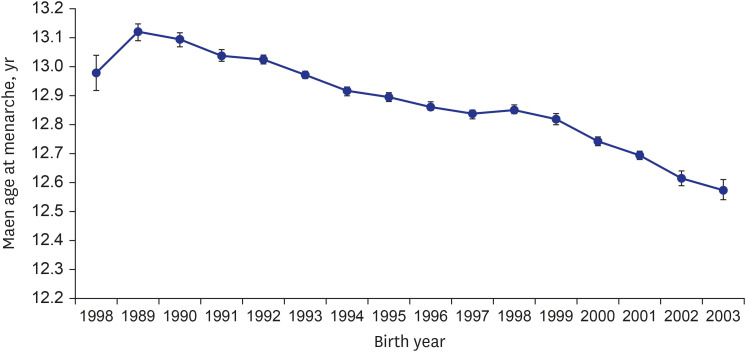
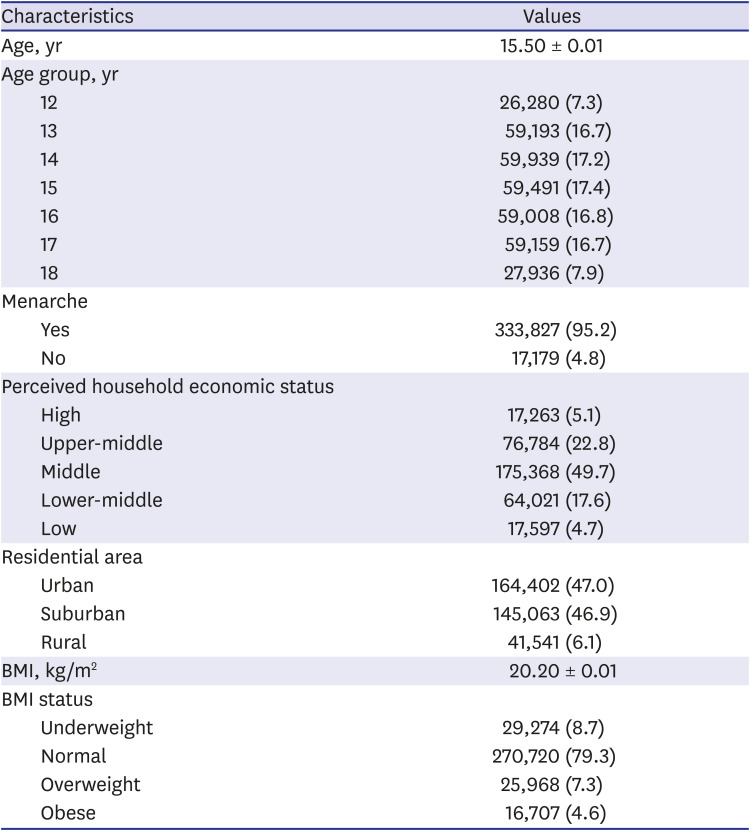




 PDF
PDF Citation
Citation Print
Print



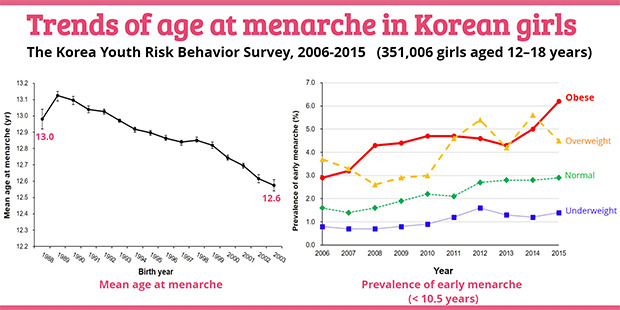
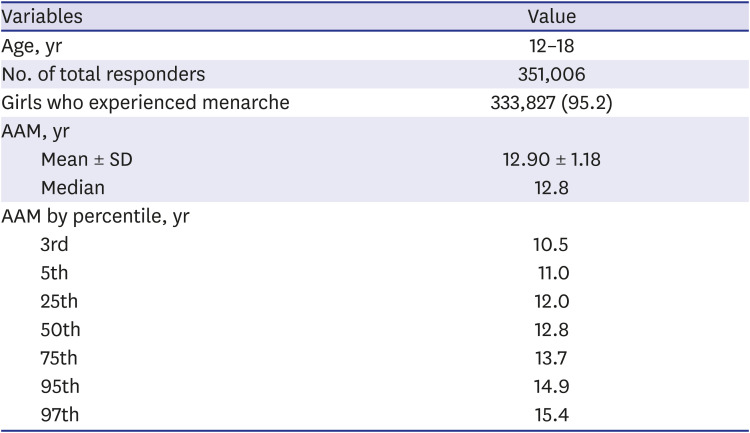
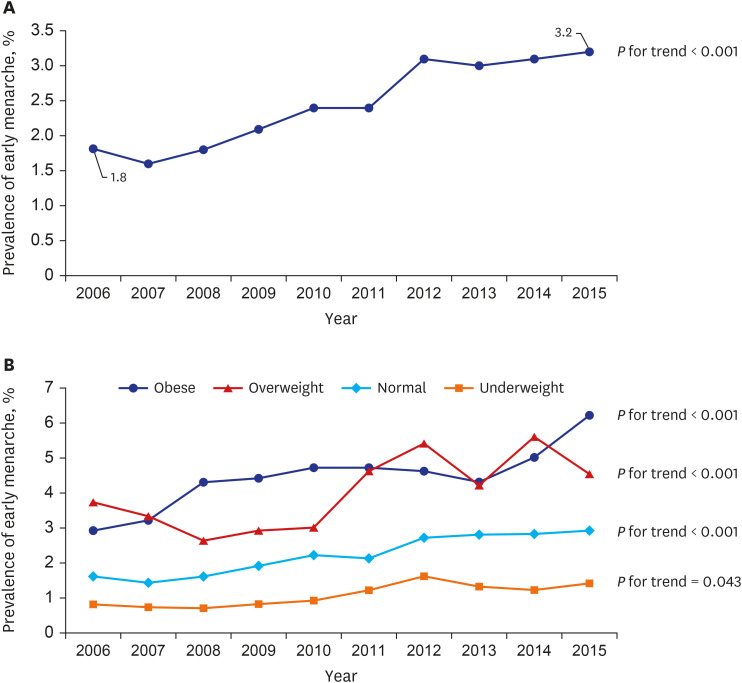
 XML Download
XML Download